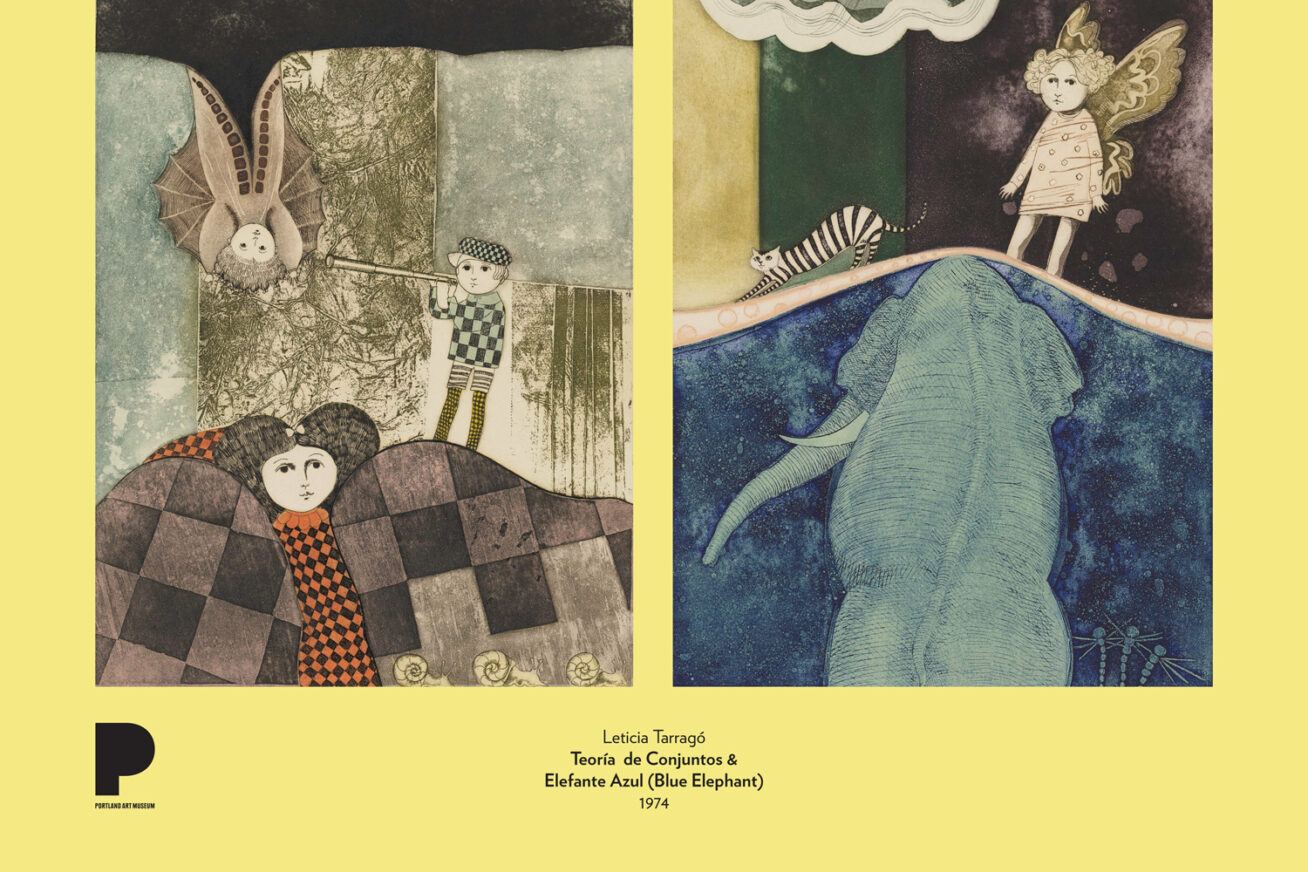
Leticia Tarragó is a printmaker, painter, and children’s book illustrator from the state of Veracruz, Mexico. She was born in Orizaba in 1940 and raised in Mexico City in a family that was passionate about art and culture. She began painting at the age of 13 and soon garnered national and international prizes and scholarships in printmaking. She studied in Poland and Holland before settling with her husband, in 1963, in the mountainous countryside—the cloud forest—outside the small city of Xalapa. Tarragó became a researcher and administrator at the Institute of Plastic Arts at the University of Veracruz and a beloved figure to the people of Veracruz who see her work as conveying their regional identity to the world.
Tarragó creates dreamlike images: intriguing constellations of animals and human figures appear in abstract landscapes of color, shape, and pattern. Tarragó insists these works do not express fantasy, rather they are drawn from her childhood experiences. The angels that appear in many of her works are based on a memory that made her feel “happy and safe as a girl.” The blue elephant portrayed here may reflect a childhood wish: “Children,” she remarks, “are given to dreams of having an elephant in the garden in the same way their parents want to have a Mercedes-Benz in the garage.” Her work consistently conveys this sense of recognizing and valuing children’s perspectives. “No adult should ever forget their childhood,” she cautions, “By doing so, they put a lock on the memories of the most beautiful part of their lives.” Tarragó places special value on her work as a children’s book illustrator: “Being asked to do a job that will be reproduced for years and that will be seen by thousands of children is a great feeling, since children are capable of perceiving things that adults do not see.”
Many wonderful animals populate Tarragó’s work. These elephants, cats, horses, and snails are not symbolic, she says, but the expression of “something natural… as if the animals or insects were one or more personages; that is, as if they also were human.” They express her understanding of the world, what she calls “the duality or ‘oneness’ of man and beast living in harmony.”
This poster brings together two works that Tarragó created in 1974: Elefante Azul and Teoría de Conjuntos. Though they are not part of a series, similar figures and patterns appear in Tarragó’s other prints from this time. In the first image here, a blue elephant appears to float up through or over a mottled blue background, perhaps a body of water, accompanied by three dragonflies. Above the surface, over the elephant, a striped cat languorously stretches as a girl with butterfly wings looks on. In Teoría de Conjuntos, we find a girl or woman, wearing a red-and-black checkered dress, tucked into a larger, checkered pattern. A boy in colorful, checkered tights, jacket, and hat holds a long, narrow telescope. A figure suspends upside down, their ribbed wings fanning open. Three snails, single file, make their way toward the edge of the frame in the lower right corner. Who are all of these creatures and how do they relate to one another?
While the title Elefante Azul translates easily from Spanish to English as Blue Elephant, the title Teoría de Conjuntos is more obscure. Teoría (pronounced teh-oh-ree-ah) means theory. Conjuntos (kohn-hoon-tohs) suggests collections, groups, ensembles, or (in math) sets; things that belong together or are joined together. Why do these figures and creatures belong together? So many of Tarragó’s works invite this question. Perhaps she asks us, the viewers, to create the story.
Discussion and activities
- Consider the title Teoría de Conjuntos. Teoría means theory. Conjuntos suggests collections, groups, ensembles, or (in math) sets; things that belong together or are joined together. What does this phrase (in Spanish or English) suggest to you? How do you relate the title to the image? How do you think the process of translation adds to, creates, or changes the meaning of the work?
- Choose one of the images in this poster. How many figures and creatures can you find? How do they relate to each other? What do you think is happening here? Place yourself into this scene, either as one of these characters, or as an observer. What do you hear, see, smell, notice? Write a story inspired by this image.
- In a 1977 interview, Leticia Tarragó said that observation was at the center of her art: “I am an introverted person, and I think this has had a big influence on the character of my work. My work is the result of having dedicated more time observing my surroundings, rather than participating in what was going on around me.” What do you think Tarragó means by this statement? How do you reconcile her statement with the non-realistic style of her work?
- Practice being an observer like Tarragó. Spend several minutes watching a group of people or animals near you. What do you notice about them? How do they interact with each other and with their surroundings? You might make notes on what you observe. Later, draw a scene inspired by what you saw, but based on memory. What stands out to you as you look back? Allow your imagination to alter or embellish the scene you observed.
- Compare Tarragó’s representation of animals in these prints to Beth Van Hoesen’s Bugs. What similarities and differences do you notice between their styles? How does each convey the characters of these animals and their relationships with humans?
Selected sources
Leticia Tarrago: A Look at the Artist and Her Work, edited by Thomas E. Schnabel, Royal Editions, New Orleans, LA, 1977.
Carlos Hugo Hermida Rosales, “En la pintura creo mis mundos: Leticia Tarragó,” Universo, Universidad Veracruzana, January 23, 2018.